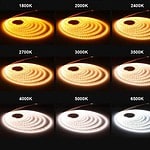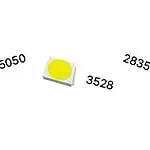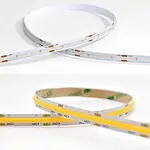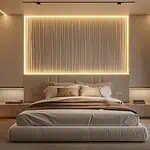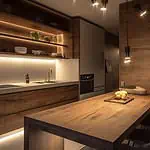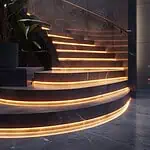Though the color temperature of the bathroom often depends on personal preferences, white light with a cool tone is the ideal pick for the bathroom. Yet you can experiment with warm lighting for a cozy vibe, or a colorful option is also ok.
To decide on the color temperature of a bathroom, first consider the tasks you may operate on that space. For instance, if you have a vanity in the bathroom where you do makeup, facials, or similar tasks, cool lighting with higher CCT works best. Again, if you want a cozy atmosphere in your bathroom where you can relax in the bathtub for hours, go for low-color temperature fixtures. Besides, there are many more to consider when picking the ideal color temperature for your bathroom, including wall color, cabinet color, interior decor, etc.
No worries, I will discuss them all in this article. So, let’s begin by understanding how these color temperatures influence the mood and functionality of your bathroom. I will also discuss how to choose the ideal color temperature for your bathroom.
Fundamental Color Temperature
A British scientist named Lord Kelvin introduced the Kelvin (K) scale for measuring color temperature. Higher Kelvins indicate cooler, bluish light, and lower Kelvins signify warm, cozy lighting. For instance, candlelight at around 1,000 Kelvin casts a warm, inviting glow. While standard household light bulbs usually hover around 3,000 Kelvins. But the brightness of natural daylight has a temperature of about 6,500K. The color temperatures for different light color outputs are as follows-
| Light Color | Color Temperature |
| Warm Light | 2700K – 3000K |
| Cool Light | 3500K – 5000K |
| Daylight | 5000K – 6500K |
The Perfect Color Temperature For A Bathroom
Cool white is the ideal color temperature for bathrooms. Based on the brand, you can choose between 3500K and 5000K color temperatures. The bluish-light color of this CCT range is ideal for bathroom taskings. In the bathroom, we do usual activities like shaving, doing makeup, and grooming. Therefore, you need a brighter white color temperature to do these in your bathroom efficiently. This light color helps you focus, alert, and concentrate on your actions. That’s why neutral white 3500K and cool white 4800K color temperature is considered the best temperature for bathrooms. Apart from this color temperature, you can choose what you like or preferences. For instance, it can be a warm tone or whatever your interior demands.
What Are The Best Lighting Options For Bathroom Color Temperature?
The color temperature depends on whether you like bright, natural light for a spa-like experience or a softer, ambient glow for your morning routine. Before picking out the color temperature, go through the fixtures suit best for bathroom lighting–
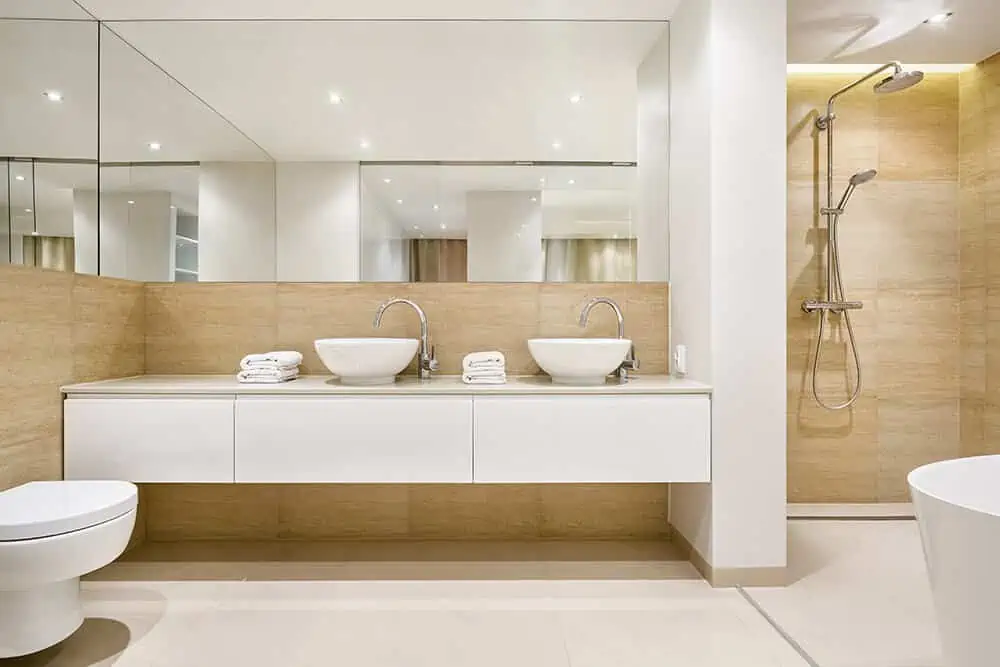
LED Strip Lights
When you’re considering switching the conventional bathroom lights for something eco-friendly, don’t just stick with CFLs or LED bulbs; give LED strip lighting a chance. LED strips are super durable, come in a bunch of colors to match your vibe, and it’s safe to use. Plus, it’s waterproof, making it the ultimate bathroom lighting solution. It is further super easy to install as the strips come with an adhesive backing. Who knew changing up your bathroom lights could be this cool and hassle-free? Here are some of the best LED strip variants for bathrooms-
- Single Color: You can select single-color strip lights for consistent and uniform illumination. It makes them suitable for creating a specific mood or accentuating certain areas in your bathroom. They typically come in warm or cool white options with multiple individual colors: red, green, blue, yellow, amber, pink, and UV. So you can find one that best suits your preference.
- Dim-to-warm: If you need a cozy vibe in your bathroom, dim-to-warm LED strip lights are the best options to choose from. You can have a wide range of customizable warm white light shades to set up your bathroom as per your mood. Along with the bathroom, these lights are perfect for spicing up your space, be it accent, cabinet, cove, or commercial lighting.
- Tunable White: Tunable white strip lights provide the ultimate flexibility. And you can adjust the color temperature to your liking, switching between warm and cool whites. This is perfect for adapting your bathroom lighting to different activities and times of day.
Recessed Lights
Recessed lighting is a popular choice for bathroom lights. You can install these fixtures into the ceiling for a clean, unobtrusive look. And choosing a cooler color temperature can offer a well-lit space. This is suitable for detailed tasks such as shaving or makeup application. But, if you lean towards a more tranquil ambiance, warmer color temperatures can create a cozy atmosphere. You will find this for winding down in the bath or a serene morning routine.
Furthermore, you can place a single recessed light of higher lumen power for small bathrooms, as it should be more than enough to distribute the ambiance throughout the area. But for a big bathroom, you may need to install multiple recessed lights to ensure uniform lighting. For information, please check IC Vs. Non-IC Rated Recessed Light Fixtures.
Layered Fixtures
Layers of lights are ideal for a well-lit place. This fixture evokes applying multiple lighting elements to illuminate the whole room. For instance, you can choose recessed lights as the primary ambient source. Also, you can include a table lamp that can enhance visibility for certain tasks such as tweezing or manicure. Then, some sconces you can add around the mirror, serving as task and accent lighting.
LED Mirrors & Vanity Lights
Illuminate your bathroom with a touch of glamor by incorporating makeup lights. These fixtures offer additional brightness for your makeup routine. You can attach these lights to a mirror or use them as the primary bathroom lighting. Plus, it’s best to always go for fixtures or bulbs with a daylight color temperature. It will ensure that the makeup you apply in the mirror accurately reflects how it appears in the outside world.
In addition, for a touch of elegance in your bathroom, think about including vanity lights. They are usually installed on the wall to offer focused brightness around the mirror. These are ideal for applying makeup, shaving, or any other activities you typically do in front of the bathroom mirror. However, you can also use LED strips for DIY mirror lighting; check this for further details- How To DIY LED Light Strips For Mirror?
Multiple Sources Of Lights
Having multiple sources of light in the bathroom is always the best idea. This allows you to customize the brightness level according to your preferences. And you can easily transition between warm and cool tones. If one source feels too intense or too subtle, you can rely on another to create the desired ambiance. For instance, you can choose to turn off the leading lights and bask in the cozy glow of the sconces by the mirror. Or, dimming the overhead lights and switching to LED strips can add a dynamic touch to your bathroom atmosphere. Besides, you have the option to place mirror edges along wall molding or attach them underneath your bathroom cabinets. Whether you choose a single color or a combination, it’s the easiest way to entirely change the look of your bathroom.
Dimmers
By using dimmers, you can get complete control over the bathroom lighting. This way, you can change the brightness of your bathroom lights and create an ideal atmosphere. More specifically, you can set strong lights when you are getting ready for a smoother temperature to calm the evening. Therefore, a simple dimmer slide is enough to change the ambiance in your bathroom entirely. For information, you can check How to Dim LED Strip Lights.
How To Select A Bathroom Color Temperature?- A Guide
When searching for an ideal bathroom color temperature, it’s essential to take into account your current or prospective bathroom decor. Also, many of these ideas you can use for selecting the best lighting in any room throughout your house.
Consider Wall Color
When light bounces off surfaces, your bathroom’s choice of wall color can also influence the overall ambiance. Therefore, if possible, experimenting with various color temperatures is recommended. In many cases, people go for a white or off-white wall color. This is a widely favored choice for bathrooms and works with a wide range of light color temperatures. But when you have a bathroom wall with a darker color or a taupe color, even a gray, you can test multiple color temperatures.
Lighting can enhance the appearance of colors. Occasionally, when incompatible colors are combined, you can notice a bluish or pinkish tint. Here’s a creative suggestion: You can examine various LED color temperatures using a photography fill lamp to find the best match for your paint color.
Cabinet Color
Vanity cabinets, storage spaces, and interior design have now become an integral part of bathroom decor. You should also consider the color and material of the cabinets while choosing the ideal light fixture. For your white cabinetry, go with a cool white color temperature, typically ranging between 3500K and 5000K. Again, if you have wooden cabinetry, you should know it looks best when illuminated with a warmer light because of its earthy tones. In this case, go for a fixture with a temperature ranging from 2700K to 3500K.
However, when you have thermofoil, textured, or painted cabinets, you have options with many color temperatures. Most of the time, any color up to 5500K to 6500K will be too sterile or bluish. Therefore, keeping the color range under 5000K would be best.
Bathroom Decor
What’s the general ambiance of your bathroom design? Does it lean towards traditional, modern, contemporary, or perhaps a transitional style? Each of these design styles requires specific lighting color temperatures. So, you have to find the best match. For instance, a traditional and rustic theme bathroom goes best with warm yellowish lighting. Again, for a modern and sleek look, bright white light is a good option to go with.
Finish Fixtures
You need to consider the finish of your fixtures, such as chrome, oil-rubbed bronze, brushed nickel, black, and brass. Each finish carries its aesthetic. Chrome gives off a sleek, modern vibe, while brushed nickel offers warmer tones. These finishes subtly influence the overall design and guide the lighting scheme.
Tasking
Bathrooms aren’t all the same. There’s the master bath, a guest bath, a half-bath, and even a quarter-bath. Each serves slightly different purposes depending on their location within the house. However, I think you can be less strict about color temperature in bathrooms other than the master bathroom. Since the primary bathroom is usually more spacious and includes more cabinetry, it requires proper illumination.
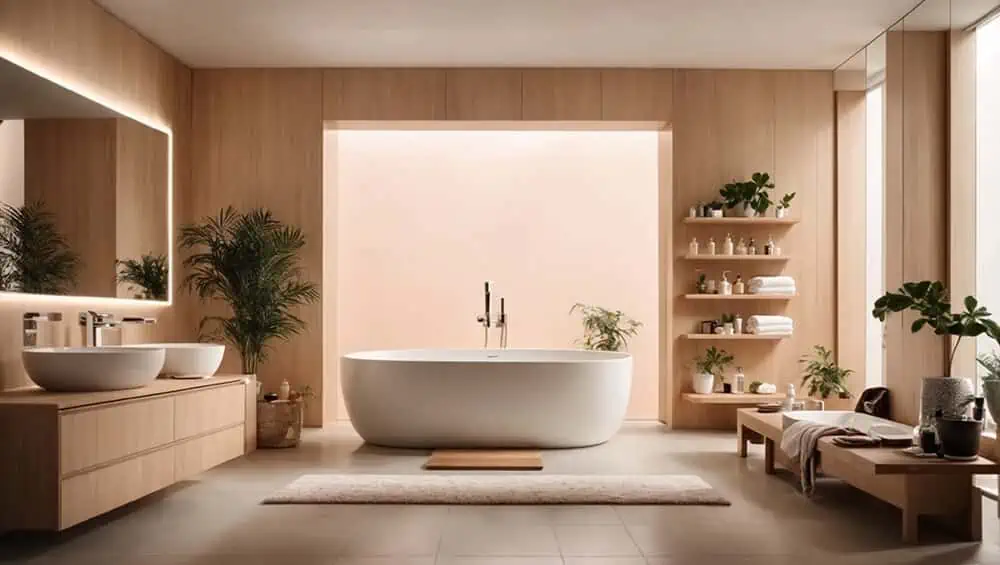
Things To Consider While Selecting Color Temperature Of Bathroom
Here, let’s see some of the factors you need to consider before choosing the color temperature of the bathroom–
Cool Or Warm: Consider The Location
First and foremost, you need to take into account the location of the bathroom for choosing a cool or warm color. For example, warm bathroom lighting sets the perfect mood for a relaxing bath. But when it’s time to do makeup, shave, etc, cool lights are the best option. The cooler the light, the more it mirrors the sunshine and the places you hang out during your day. So, for a flawless makeup application, go for cool lighting. And when it’s a spa day, bask in the cozy warmth of soothing lighting. Besides, the mood in your bathroom can change with the color temperature of your lights. Want a cozy vibe? Use warm colors at 2700K-3000K for a soft, yellowish glow. It’s like a warm hug for your space.
However, for a chic, contemporary feel, opt for 3500K-4000K. Your bathroom will pop with a brighter, whiter light and make it look fresh and spacious, like a stylish oasis. Some recommended color temperatures for different locations are–
| Bathroom Location | Recommended Color Temperature |
| Residential Bathroom | 2700K to 3000K |
| Hospital Bathroom | 3500K to 4100K |
| Hotel Bathroom | 3000K to 4000K |
CRI
The Color Rendering Index (CRI) is a rating with a maximum value of 100. It measures how colors appear under a light source compared to natural sunlight. A higher CRI number (90 or higher) lets you perceive color distinctions. This information is typically available on the product label of light fixtures or in the manufacturer’s specifications. Hence, CRI enhances the colors of objects illuminated by the light source.
For instance, in a grocery store, a top-notch light fixture with a high CRI rating can make a yellow banana look even more yellow and a red apple appear even redder. This way, the owner of the shop can attract more customers. The color rendering index is essential for achieving accurate colors under a particular light source, with a CRI of 90+ being the ideal choice for precise color representation. Therefore, the specific color temperature of a light bulb becomes less significant if combined with a lower CRI rating, such as 80.
Brightness (lumen & wattage)
The brightness (lumens) and power (wattage) of the lighting are also essential factors to consider. And to effectively light up your bathroom, these factors should not be overlooked. But what exactly do they mean by ‘Lumen’ and ‘Watt’?
Lumen
Lumens measure the illumination of a light source. And the higher the lumens, the brighter the light. This can have a notable impact on the perception of color temperature. Even if the color temperature remains constant, different lumen values can slightly modify the illuminated area’s appearance. For instance, you could have a light bulb with a color temperature of 5000K but with varying wattage and lumen output:
- 5000K color temperature with a 100-watt bulb provides 1500 lumens
- 5000K color temperature with a 60-watt bulb offers 750 lumens
So, if you want a brighter light, choose for a higher lumen value. Or, if you prefer a dimmer light, go for a lower lumen value.
Wattage
A watt is essentially a measure of energy consumption. Many small gadgets and light bulbs require minimal power and wattage to function. Modern LED fixtures generate more illumination while consuming fewer watts in today’s LED technology. This makes lumens a more relevant measurement than watts to calculate brightness. However, check this to explore more about lumens and wattage to pick the right rating for your bathroom- Lumen to Watts: The Complete Guide.
Smart Lighting Features
Don’t overlook smart lighting factors while choosing the perfect color temperature for the bathroom. For instance, if you love to have a relaxing bath, you need to choose dimmer settings. This way, you can give your bathroom a proper look when bathing. Plus, for the convenience option, you can go with motion sensor lights, as there is no need to turn on the lights. Thus, smart lighting adds a touch of convenience and tech-savvy sophistication to your bathroom ambiance. For more ideas, check this- Top 26 Creative Bathroom Lighting Ideas.
FAQs
Color temperature is measured in Kelvin (K). By using this, you can find out the warmth or coolness of light. The lower Kelvin values (2000-3000K) bring a yellowish-warm hue. In contrast, higher values (4000K-5000K) indicate cooler, daylight-like tones. Also, you can use a color temperature meter or check product labels for accurate measurements.
For home settings, a warm, yellowish light between 2700K and 3000K works well in living rooms, bedrooms, hallways, and dining rooms. Meanwhile, a neutral white light at approximately 4000K is a good choice for bathrooms and kitchens. Because you need to do a more functional job in the bathroom, like makeup.
No, you can install lights with 2700K to create a cozy ambiance. This will give your bathroom a gentle, golden radiance with a sense of comfort. With it, you can do a spa or take a relaxing bath after a long day. This light temperature will help you to remove all the stress while showering, and you will feel refreshed after that.
Color temperature, measured in Kelvin (K), typically ranges from 2700K to 5000K. Selecting a color temperature between 3000K and 4000K in bathrooms is best. This range combines a warm, welcoming ambiance with excellent makeup application and shaving lighting.
In the bathroom, to look good, you can use white or daylight LED lights with a color temperature of around 4000K to 5000K. These lights provide a natural and bright illumination, which helps you see yourself more accurately in the mirror and get the most flattering look when applying makeup or grooming.
You can tell if a light suits a bathroom by considering its moisture resistance rating. Therefore, you have to look for lights with an IP44 rating or higher, as they can handle bathroom humidity. Also, by matching the right color temperature to your bathroom decor, you can find suitable lights.
The Color Rendering Index (CRI) of your bathroom lighting tells you how well it shows the true colors of objects. A higher CRI (around 90 or more) ensures colors appear as they should. So, you need to avoid a lower CRI than 90 for accurate color representation in your bathroom.
In more spacious areas like master bathrooms, 75 to 100-watt incandescent bulbs are suitable. Conversely, smaller bathrooms or powder rooms are properly lit with 40 to 60-watt bulbs.
The number of lights you need in a bathroom mainly depends on its size. For a standard 5×8-foot bathroom, a single ceiling light with about 75-100 watts is usually sufficient. However, additional fixtures will be required in larger bathrooms for proper illumination. Generally, you can aim for around 20 lumens per square foot for adequate lighting.
Warm and cool lights have different purposes in the bathroom. For instance- warm white light is perfect for creating a comfortable and relaxed atmosphere in your bathroom. Especially for activities like bathing and using the toilet. But, for lighting fixtures near the mirror, where you do tasks like shaving, plucking, or skincare, a cooler white light at 4000K is the best choice. So, considering your bathroom lighting requirements, pick the color that helps you best in bathroom taskings.
Bottom Line
Consider your daily rituals and the mood you want to set before selecting the ideal color temperature for your bathroom lighting; then, decide what color temperature you want to have. You can choose between cooler or warmer color temperatures that range from 4000K-5000K and 2700K-3000K, respectively. In choosing this, consider the wall color, the task you operate in your bathroom, cabinets, etc. And then match the light fixtures with the bathroom decor.
However, LED strip lights are perfect for bathroom lighting as they are waterproof, have variable CCT, and are easy to install. Check LEDYi’s tunable white and dim-to-warm LED strip lights for adjustable color temperature. We also have RGB LED strips if you want to bring colorful lights to your bathroom. So, place your order ASAP and get the desired color temperature for your bathroom.
